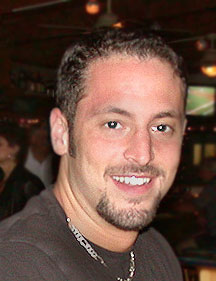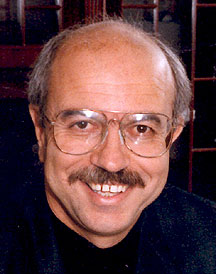Baran and Nicolaou Win
Nobel Signature Award
By Jason Socrates Bardi
Where most prizes awarded to chemists recognize individual achievement,
one prestigious prize, the Nobel Laureate Signature Award for Graduate
Education in Chemistry, recognizes the achievements of both an outstanding
graduate student and his/her mentor.
The 2003 winners of the Nobel Laureate Signature Award, who are chosen
each year by the American Chemical Society (ACS), are The Scripps Research
Institute's (TSRI) Phil Baran and K.C. Nicolaou. At next year's annual
ACS meeting, they will both receive awards sponsored by the company Mallinckrodt
Baker, Inc. of cash prizes and plaques inscribed with the signatures of
Nobel laureates.
Baran is a 2002 graduate of the TSRI Chemistry Program, and Nicolaou
is the Aline W. and L.S. Skaggs Professor of Chemical Biology and Darlene
Shiley Chair in Chemistry. When he graduated last May, Baran was 24, the
youngest graduate ever of TSRI's Chemistry Program.
"Phil Baran was a phenomenal student at TSRI—tenacious, enthusiastic,
brilliant, imaginative, and so much more," says Nicolaou. "He grew up
here both as a young man and as a scientist. He matured to the point where
I think he is now a formidable synthetic chemist with an exciting career
ahead of him."
Baran, for his part, credits his success to Nicolaou's mentoring during
the four years Baran worked under him. And he also feels he would not
be where he is today without Professor David Schuster of New York University,
with whom he worked as an undergraduate and published six papers.
"I saw Dr. Nicolaou give a lecture [at the Nichols Award symposium in
New York City] in 1996, and I knew from that moment that I wanted to work
for him," says Baran, who came to TSRI the following year." The training
I received was second to none."
"Phil needed little direction from me," insists Nicolaou. "He combined
beautifully a sharp mind with a pair of golden hands, accomplishing an
incredible volume of work."
That work involved the total synthesis of the molecules CP-263,114 and
CP-255,917. These "CP molecules" are both natural products of a fungus
that was found on a twig of a Texas juniper tree in the 1990s. These two
similar molecules inhibit the enzymes squalene synthetase and ras farnesyl
transferase, which are implicated in high cholesterol and certain types
of cancer.
Their activity and potential use as scaffolds upon which to design anti-cancer
and cholesterol lowering drugs makes the CP molecules interesting targets
for synthesis, but their complexity—which Nicolaou calls diabolical—made
the synthesis seem a daunting task. Baran, however, was undaunted from
the beginning and invited the challenge.
"When I first got here in July 1997, the CP molecules 'spoke' to me,"
he says. "My heart turned inside out and my mind started racing, and I
just had to go to the laboratory."
And go to the laboratory Baran did. For the next two years, he spent
days, nights, weekends, and holidays in the laboratory, wholly devoted
to completing the total synthesis of the CP molecules, which he accomplished
in April of 1999.
Along the way, he and Nicolaou discovered many new synthetic tools and
methodologies—ways of carrying out a reaction that can be used not
only for synthesizing a particular CP molecule, but also generalized for
many synthetic reactions.
These new reactions and technologies are often one of the most important
parts of a total synthesis project, as they may enable the drug discovery
and development process for other compounds. Many of these discoveries
Baran and Nicolaou described in some of the more than 30 papers they published
during Baran's years as a graduate student at TSRI.
Most recently, the two wrote a review on the synthesis of the CP molecules
and all the discoveries they made along the way, and this appeared on
the cover of the August 2, 2002 issue of the journal Angewandte Chemie.
Synthetic chemistry, says Baran, is something like mountain climbing.
Except rather than simply reaching a new peak that nobody has summited
before, you are also inventing new harnesses, ropes, and climbing tools
as you go. And you are finding ways to ascend with fewer steps than anyone
has ever done before.
The journey up the CP mountain, adds Baran, was the most physically
and mentally challenging part of his life. And also the most rewarding.
"[Phil] is full of ideas and has great creative ability," says Nobel
laureate E.J. Corey of Harvard University, who was Nicolaou's post graduate
advisor and who hired Baran last year to do a postdoctoral fellowship
in his laboratory.
"He's a joy to work with," Corey adds. "K.C. did a superb job of bringing
him along."
Go back to News & Views Index
|

"Phil Baran [above] was a phenomenal student at
TSRI," says renowned chemist K.C. Nicolaou, Baran's mentor.

Baran knew from the moment he heard K.C. Nicolaou
(above) lecture that he wanted to work for him. "The training I received
was second to none," says Baran.
|



